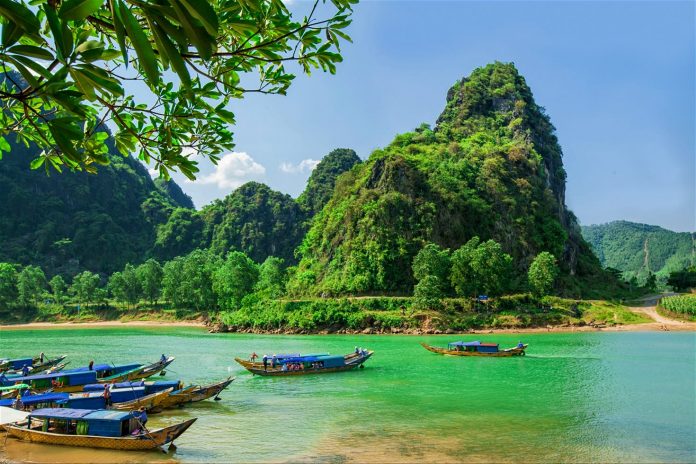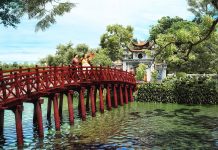Among thousands of interesting places in Vietnam, there are 8 UNESCO World Heritage Sites in Vietnam until 2018. There are 5 cultural sites on the list, while 2 are natural ones. The last one Trang An Complex is a mixed site
1. Halong Bay – UNESCO World Heritage Site listed in 1994
Halong Bay was listed in 1994 as a World Heritage Site by the United Nations Education, Science and Culture Organization. Having been a famous destination for years, this site becomes even more renowned after this world famous recognition. With 1960 islands in different sizes and an unbelievable smooth sea surface, Halong Bay has written its name to one of the worthiest places in the world to visit. An especially great time to visit Halong is in May when the annual Halong Bay carnival takes place.
2. Phong Nha Ke Bang- UNESCO World Heritage Site listed in 2003
Phong Nha Ke Bang Park does not have a long history like Halong Bay but the area bears its own ace. It has the largest grotto in the world, as well with the longest underground river. Moreover, Phong Nha has rocks and stones naturally set in different sizes and shapes and a wide range of living creatures inside the park. Son Doong Cave, the largest cave in the world, was recently discovered in this complex of natural wonders.
3. Hue Complex of Monuments- UNESCO World Heritage Site listed in 1993
The Complex of Hue monuments is a combination of many royal aspects from the Nguyen dynasty (the last feudal dynasty of Vietnam) with the Imperials City (Hoang Thanh Hue) including the famous High Noon Gate (Ngo Mon), many tombs of Nguyen Emperor (Gia Long, Minh Mang, Thieu Tri, Tu Duc, Dong Khanh, Khai Dinh..), monuments, temples, pagodas, and load of other interesting elements. A visit to Hue will not be complete without a day spent on appreciating the historical values of Hue citadel and tombs.
4. Hoi An Ancient Town – UNESCO World Heritage Site listed in 1999
Ancient Town Hoi An is already famous for its Chinese and Japanese influence on architecture, hand made toys (lantern, lotus floating candle) and the biggest and most marvelous Full Moon Festival (Trung Thu) of the country. Moreover, the bridge buit by Japanese here and many Chinese Assembly Halls are the most attractive places for the tourists. Formed in the 16th and 17th century and thriving as a trading points of various countries, Hoi An now still retains much of its trait since the old days: from family cult houses to community gathering place and colorful pagodas.
5. My Son Sanctuary – UNESCO World Heritage Site listed in 1999
My Son Sanctuary, containing somewhat 70 ruined and abandoned Hindu temples and tombs, was built by Champa Kings between 4th and 14th Century AD. These temples here once were the place for the royal family of Champa to remember their ancestors and worship their Gods. Plus the wild nature of the place, My Son creates a wonderful scene for people visiting the Holy place.
6. Thang Long Imperial Citadel – UNESCO World Heritage Site listed in 2010
Thang Long Imperial Citadel, which has been declared a World Heritage in 2010, is a very strong citadel, standing in Hanoi from 11 century after Ly Thai To moved the capital here. The Citadel was once the living place of many royal families: Ly Dynasty, Tran Dynasty, Le Dynasty, Trinh Dynasty…and nowadays become one of the most famous Citadels of the country.
7. Ho Dynasty Citadel – UNESCO World Heritage Site listed in 2011
Ho dynasty fortress in Thanh Hoa province is the only one ancient stone Citadel left in Southeast Asia, built in 1397 with unique architecture and beautiful natural base. Moreover, Ho fortress is combined by many heavy stone packs, some of them weight more than 20 tons, strong enough to against even the most powerful campaign at that time. In addition, inside the fortress, archeologist found the stone balls for cannon (Ho Nguyen Trung is the inventor of cannon gun), one of the oldest cannon balls in Asia.
8. Trang An Landscape Complex – UNESCO World Heritage Site listed in 2014
Located in Ninh Binh, this area is known for its scenic landscape and boat cave tours. It was included into the list of UNESCO World Heritage Sites in Vietnam in 2014 both for its cultural and natural value. It is often called as the “Inland Ha Long Bay”. The landscape features several limestone karst peaks, valleys, and steep cliffs. The caves had been explored by scientists that were able to uncover evidence of human activity within the cultural landscape dating back to 30,000 years ago. According to the evidence gathered, the people who lived in the area were seasonal hunter-gatherers. There are also small villages, temples, ride paddy fields, and pagodas within the area.













